Geometry » Similarity
Contents
1. When are two figures similar?2. Special case: the triangle
3. Examples
3. More examples (beak and hourglass figure)
1. When are two figures similar?
Two figures are similar when:
- the corresponding angles are equal in size
and
- the corresponding sides have the same scale factor.
An enlargement is always similar to the original.
If figure B is an enlargement of A, you may assume that figure A and B are similar.
Example:
Are the quadrilaterals below similar?
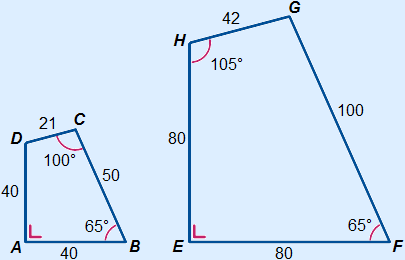
Are the corresponding angles equal?
 A =
A =  E = 90°
E = 90°
 B =
B =  F = 65°
F = 65°
 C =
C =  G = 360° – 90° – 65° – 105° = 100°
G = 360° – 90° – 65° – 105° = 100°
 D =
D =  H = 360° – 90° – 65° – 100° = 105°
H = 360° – 90° – 65° – 100° = 105°
Are the scale factors equal?
80 : 40 = 2
80 : 40 = 2
42 : 21 = 2
100 : 50 = 2
Both conditions are met, so yes, quadrilateral ABCD is similar to quadrilateral EFGH.
2. Special case: the triangle
A special case is the triangle. Because this shape has only three sides you need less information to draw a triangle. If you know one angle and two sides, you can already draw the triangle. This results in the fact that not both the similarity rules have to apply before you know that to figures are similar. If only one of the similarity rules apply, you already know for certain that the two triangles are similar.
Two triangles are similar when:
| - | the corresponding angles are equal in size (two is actually also sufficient, as the third angle always has to make 180°) |
| or | |
| - | the corresponding sides have the same scale factor. |
Examples
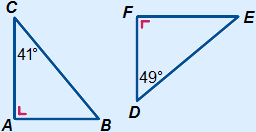 Is ΔABC similar to ΔDEF?  A = A =  F = 90° F = 90° B = B =  D = 180° – 90° – 41° = 49° D = 180° – 90° – 41° = 49°Always write the third angle as well:  C = C =  E = 180° – 90° – 49° = 41° E = 180° – 90° – 49° = 41°Conclusion: Angles are equal, the triangles are similar. |
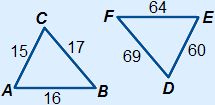 Is ΔABC similar to ΔDEF? 60 : 15 = 4 64 : 16 = 4 69 : 17 = 4117 Conclusion: Scale factors are different, so the figures are not similar. |
3. Examples
Example 1
See the figure below.
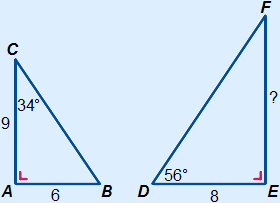
Calculate EF.
Answer:
Triangle ABC is similar to triangle EDF (letters on the same place as the corresponding angles), because:
 A =
A =  E = 90°
E = 90°
 B =
B =  D = 180° – 90° – 34° = 56°
D = 180° – 90° – 34° = 56°
 C =
C =  F = 180° – 90° – 56° = 34°
F = 180° – 90° – 56° = 34°
The scale factor is 8 : 6 = 113.
Remember: NEVER round off scale factors, use a fraction instead!
EF = 9 × 113 = 12
Example 2
See the figure below.
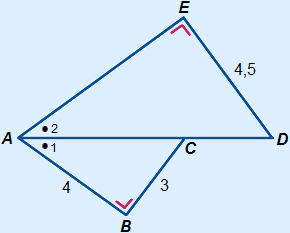
Calculate AE and AD.
Answer:
Triangle ABC is similar to triangle AED, because:
 A1=
A1=  A2
A2
 B =
B =  E
E
The scale factor is is 4.5 : 3 = 1.5.
You need Pythagoras' theorem to calculate AC.
AC =  = 5, you may also use a scheme to calculate AC.
= 5, you may also use a scheme to calculate AC.
AE = AB × 1.5 = 4 × 1.5 = 6
AD = AC × 1.5 = 5 × 1.5 = 7.5
4. More examples
Example 1 contains a beak figure.
Example 2 contains an hourglass figure.
Example 1
See the figure below.
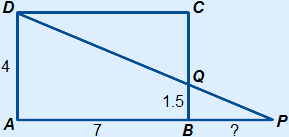
Given is that ABCD is a rectangle.
Calculate BP.
Answer:
Triangle DQC is similar to triangle BPQ, because:
 D2 =
D2 =  P (because of Z-angle, check angles)
P (because of Z-angle, check angles)
 C =
C =  B = 90° (rectangle)
B = 90° (rectangle)
The scale factor is (4 – 1.5) : 1.5 = 123.
BP = CD : 123 = 7 : 123 = 415
Note: You can also use triangle APD, but in that case you need to solve an equation to get to you answer. See also example 3.
Example 2
See the figure below.
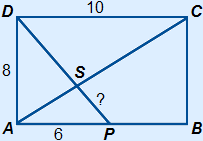
Given is that ABCD is a rectangle.
Calculate PS.
Answer:
Triangle APS is similar to triangle CSD, because:
 A2 =
A2 =  C2 (because of Z-angle)
C2 (because of Z-angle)
 P1 =
P1 =  D2 (because of Z-angle)
D2 (because of Z-angle)
The scale factor is 10 : 6 = 123.
We need to calculate PS, but you cannot do that straight away.
What we do know of PS is the following:
PS + DS = PD
DS = 123 × PS
PD can be calculated using Pythagoras =  = 10 cm.
= 10 cm.
You may also use a scheme to calculate PD.
With the data above, we can change the formula to an equation:
(you subsitute DS = 123 × PS and PD = 10 into the formula)
| PS + DS | = PD |
| PS + 123 × PS | = 10 |
| 223PS | = 10 |
| PS | = 10 : 223 = 334 cm |